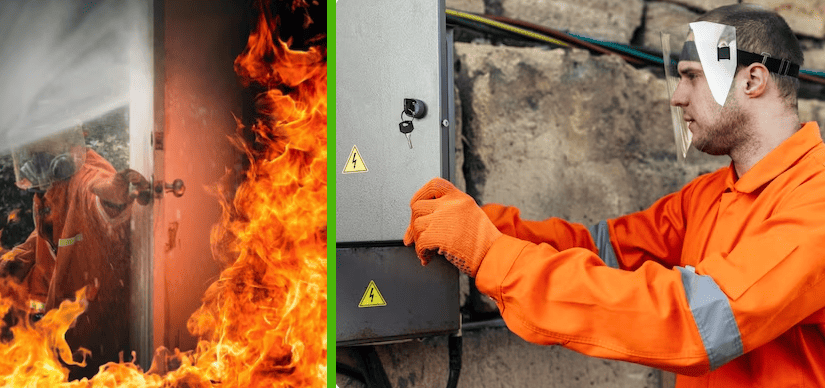Fireproofing Your Home: Proactive Measures for Preventing Fire Damage
One of the most devastating and life-threatening accidents at home is fires. They are the cause of property loss and life as well. This is why knowledge of causes, effects and measures for preventing fire damage at home is crucial.
Since prevention goes a long way, as a resident, one should be aware of the proactive fireproofing measures that enhance the safety of your home. This article contains all the guidelines for fireproofing your home through proactive solutions.
Here is a comprehensive guide covering various aspects of fireproofing:
1. Landscaping and Exterior Considerations:
- Defensible Space: Maintain a defensible space around your home by clearing dead vegetation, leaves, and other flammable materials. Keep this area free from trees and shrubs that can act as fuel for fires.
- Fire-Resistant Plants: Choose fire-resistant plants for landscaping. Succulents, deciduous trees, and well-irrigated lawns are examples of vegetation that can resist ignition during a fire.
- Clearance from Structures: Ensure a safe distance between trees, bushes, and structures. Trim branches that overhang the roof and clear away dead vegetation near your home.
2. Roof and Attic Fireproofing:
- Fire-Resistant Roofing Materials: Opt for fire-resistant roofing materials such as Class A asphalt shingles, metal, or tile. These materials are less likely to ignite in the event of an external fire.
- Gutter Maintenance: Keep gutters clear of debris, as dry leaves and branches can become fire hazards. Install gutter guards to prevent the accumulation of flammable materials.
- Spark Arresters: Install spark arresters on chimneys and stovepipes to prevent sparks from escaping and igniting nearby vegetation.
- Attic Vents: Use ember-resistant vents in the attic to minimize the risk of ember intrusion during a fire.
3. Exterior Walls and Windows:
- Fire-Resistant Siding: Choose fire-resistant siding materials such as stucco, brick, or fiber cement. Avoid wood siding in fire-prone areas.
- Tempered Glass Windows: Consider using tempered glass windows, which are more resistant to heat and less likely to break during a fire.
- Window Shutters: Install fire-resistant shutters to protect windows from radiant heat and airborne embers.
4. Fireproofing the Interior:
- Fire-Resistant Materials: Fire-resistant Home Design is an effective solution. So, furnishing your home with fire-resistant materials is a good option. Avoid highly flammable items like certain fabrics and opt for fire-retardant treatments where possible.
- Fireproof Safes: Keep important documents and valuables in a fireproof safe. These safes are designed to withstand high temperatures and protect contents during a fire.
- Electrical System Inspection: Regular inspection and maintenance is crucial for electrical fire prevention. Faulty wiring can lead to electrical fires. Consider upgrading to a modern electrical system if needed.
- Appliance Safety: Ensure that appliances are in good working order. Overloaded circuits and faulty appliances can be fire hazards.
5. Firebreaks and Fire-Resistant Fencing:
- Creating firebreaks and installing fire-resistant fencing are crucial elements in safeguarding your home from wildfires. Firebreaks involve clearing vegetation and creating gaps that act as barriers, slowing down or redirecting the progress of a fire.
- Choose non-combustible or fire-resistant materials for fencing, such as metal, stone, or concrete, to prevent the rapid spread of flames. These measures help protect your property by minimizing the risk of a wildfire reaching your home.
- Consulting with local fire authorities can provide guidance on the most effective implementation of firebreaks and fire-resistant fencing tailored to your specific environment and landscape.
6. Fire Safety Equipment:
- Smoke Alarms: Smoke alarms installation in key areas of your home, including bedrooms and hallways. Test them regularly and replace batteries annually.
- Fire Extinguishers: Have multipurpose fire extinguishers in easily accessible locations. Ensure that household members know how to use them effectively.
- Sprinkler Systems: Consider installing a residential sprinkler system. These systems can quickly suppress fires and minimize damage.
- Emergency Escape Plan: Develop and practice an emergency escape plan with all household members. Identify escape routes and meeting points outside the home.
7. Proactive Maintenance:
- Chimney Cleaning: Regularly clean and inspect chimneys. Creosote buildup in chimneys can ignite and cause a dangerous chimney fire.
- Dryer Vent Maintenance: Clean dryer vents regularly to prevent lint buildup, a common cause of household fires.
- Gas Leaks: Regularly check for gas leaks. A gas leak combined with an ignition source can result in a catastrophic fire.
8. Education and Preparedness:
- Fire Safety Education: Educate your family about fire safety. Ensure that everyone knows the dangers of fire and understands the importance of prevention.
- Emergency Contacts: Keep a list of emergency contacts readily available. Include local fire department numbers, as well as neighbors and family members.
- Community Preparedness:Participate in community fire preparedness programs. Being part of a community effort can enhance overall home fire safety.
9. Insurance Coverage:
- Review Policies: Regularly review your homeowner’s insurance policy. Ensure that it adequately covers potential fire damage, including rebuilding costs and contents replacement.
- Document Possessions: Keep an inventory of your possessions, including photographs or videos. This documentation can be invaluable when filing insurance claims.
10. Wildfire Preparedness:
- Evacuation Plan: As an important measure of seasonal fire safety, create a defensible space around your property. Have an evacuation plan in place.
- Emergency Kit: Prepare an emergency kit with essentials such as water, non-perishable food, medications, and important documents. Keep it easily accessible.
- Communication Plan: Establish a communication plan with family members and neighbors during a wildfire event. Ensure everyone knows how to stay informed and connected.
Best Fire Prevention Tips
Quick fire prevention tips are discussed here, some of which are also DIY Fire Damage Prevention.
- Install smoke alarms on every floor and test them monthly.
- Keep fire extinguishers in key areas and know how to use them.
- Creating a fire escape plan with multiple exit routes and practicing once or twice a year is useful.
- Regularly inspect electrical wiring, appliances, and heating systems.
- Kitchen fire prevention tips include not to leave cooking unattended and keep flammable items away from stovetops.
- Use candles safely, placing them in sturdy holders and never leaving them unattended.
- Smoke outside and dispose of cigarette butts properly.
- Store flammable liquids in approved containers away from heat sources.
- Maintain a defensible space around your home by clearing dead leaves and vegetation.
- Stay informed about common fire hazards and regularly review fire safety tips with your family.
Conclusion:
Fireproofing is a safety measure, precisely a proactive measure of safety for your home. As seen through the guidelines, it is a combination of landscaping measures, structural considerations, safety equipment, and proactive planning. Beside implementing these fire safety measures, staying vigilant is key so you reduce the risk of fire damage and create a safer living environment for you and your family. Regular maintenance, education, and community involvement contribute to a comprehensive and effective approach to preventing fire damage at home.


